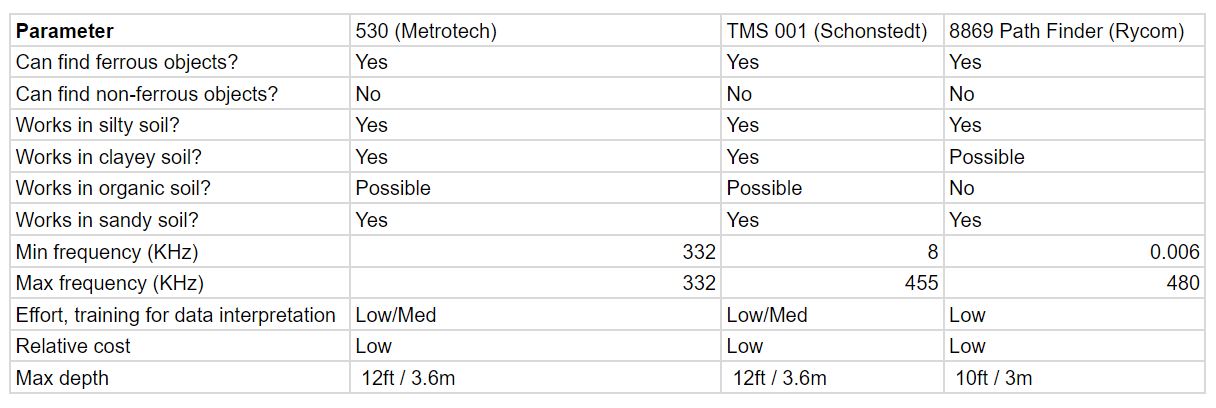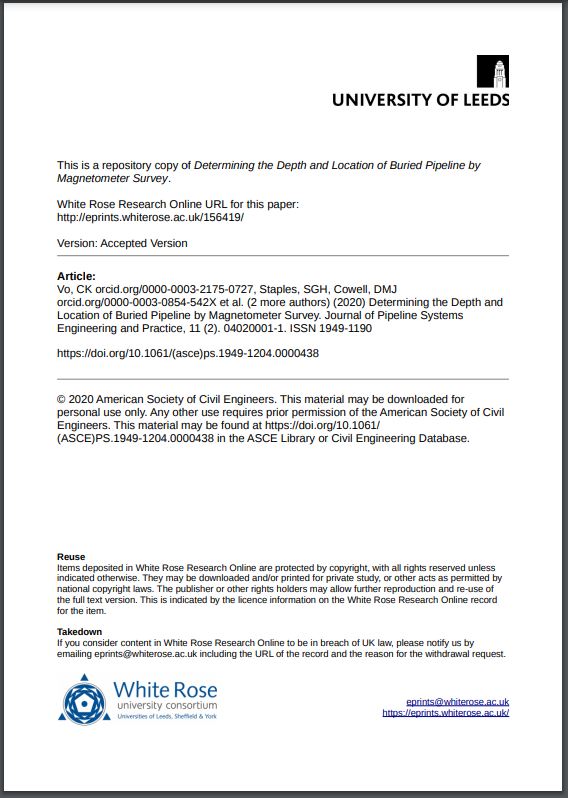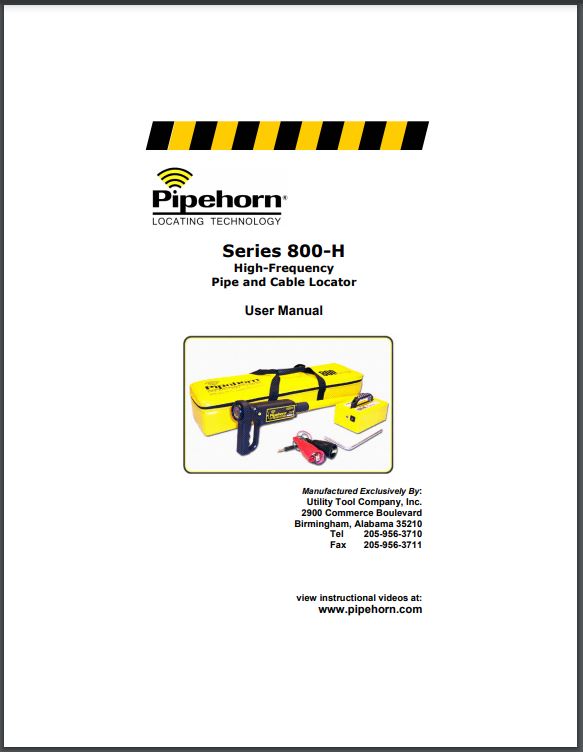 Ultra High Frequency Conduction Pipe and Cable Locators Overview.
Ultra High Frequency Conduction Pipe and Cable Locators Overview.
High Frequency Conductive Pipe and Cable Locators.
High-frequency locators are effective for detecting conductive utilities with low conductivity and various diameters with up to approximately 3.5 meters deep, using locating frequencies ranging from about 65kHz to 480kHz.
Methods:
-Direct connect
-Induction
-Signal Clamp*
Limitations:
-Short distance locating
-Prone to distortion and signal bleeding
For Locating Buried:
-Street Lighting
-Broken Tracer Wire/Tape
-Cast Iron pipelines
-Pipes with breaks, gaskets
-Highly corroded pipes or cables
and Blind clearance Searches
High frequency conductive locators are used for locating utilities that are conductive resistant or have a poor conductive surface. By using high frequencies, typically above 30 kHz, these locators can detect the electromagnetic field around a utility.
This technology is particularly useful for tracing short distances and for locating utilities in congested areas where lower frequencies might not be as effective.
The high frequency provides a sharp signal that can be easier to identify, making it suitable for distinguishing between closely spaced utilities.
 Advantages of using High Frequencies.
Advantages of using High Frequencies.
Advantages are that high frequency locators can work within Silt or clay soils.
There high frequency allows the signal to penetrate highly conductive mediums, induct onto resistant lines, and across gasketed joints or other non-conductive joints.
Utility Locating Technology Comparison Questions and Answers
The following table gives you a matrix to compare high frequency utility locating equipment.
High Frequency Utility Locator Technology Questions and Answer Overview.
Can find ferrous objects? Yes
Can find non-ferrous objects? No
Works in silty soil? Yes
Works in clayey soil? Possible
Works in organic soil? Yes
Works in sandy soil? Yes
Min frequency (KHz): Model specific, examples as low as, 0.006 (6Hz), 8 (8000Hz) and some manufactures have 332ktz (332,000Hz) models as the devices lowest frequency.
Available frequencies: Locator Specific
Max frequency (KHz): 480 (480,000Hz) Using high frequency modes in Australia can interfere with emergency radio bandwidths and can effect sensitive equipment.
Effort, training for data interpretation: Low/Med, manufacture training, online course, in-person field training recommended.
Relative cost: Low/Medium ($1300~$2200)
Max depth: 3.6m
Specific Applications: Detecting buried street lighting, broken trace wires, tape and cast iron pipes.
Specific Utilities that can be located: old cast iron gas pipelines, broken trace wire or tape, and pipes with rubber gaskets or plastic intervals.
 Applications of High Frequency Locating
Applications of High Frequency Locating
What types of underground utilities can be identified using High Frequency Conductive Pipe and Cable Locators? Here is a list of some and context for utility locating.
Some key examples of best use cases are:
-Thin or broken (if still grounded) trace wires,
-Pipes with connection gaps
-Metal Sheath of optic fibers (if grounded on both ends)
-Low conductive highly corroded pipes.
Can be used for underground utilities that are smaller in diameter (not for large distribution), conductive, and can be buried up to about 3.5 meters in depth, which include a variety of infrastructure components crucial for urban and rural services.
Here's a list of some common types of such underground utilities:
Telecommunication Cables: This includes fiber optic cables and copper telephone lines. While fiber optics themselves are not conductive, they are often bundled with conductive elements (tracewire, auxiliary copper line, metal sheath).
Gas Pipes: Small diameter metal pipes are used for the distribution of natural gas. These are conductive due to their metal construction and are buried at depths to protect against surface activities. Plastic Gas lines can also have very thin or broken trace wires. High frequencies can bleed the signal past isolation on metal pipes and gaps with broken tracewires (if grounded on both ends).
Water Supply Pipes: Smaller diameter copper or galvanized steel pipes may be used for water supply in older installations. Newer installations might use plastic materials, which are not inherently conductive, but tracer wires are often buried alongside to aid in their detection.
Irrigation Control Wiring: Used in agricultural and landscape management, these wires control irrigation systems.
Cable Television Lines: Coaxial cables used for cable television and broadband internet services are conductive, thanks to their metal shielding and core.
Street Furniture Power Supply: This includes power supplies for bus shelters, kiosks, and advertising billboards. The cables are conductive and buried to connect these structures to the electrical grid.
 Limitations of High Frequencies
Limitations of High Frequencies
There advantage is also there downfall. Due to the high frequencies used, the signal can conduce onto other nearby conductive pipes and cables much easier. They can also interrupt communication signals at 400hz and above in some countries.
 Conclusion of High Frequencies Locating
Conclusion of High Frequencies Locating
What's the conclusion of High Frequencies Locating for excavation? They can be essential tool for saving time, money and avoiding personal injury or asset damages.
High Frequencies Locating are invaluable tools in specific situations in the the field of utility locating and mapping, providing a reliable method for detecting thin gas pipes and abandoned corroded pipes. Reliable upto 3.5 meters. Signal can bleed to other utilities in congested urban areas with multiple utilities.
Their ability to find specific targets when locating, makes them a go-to choice for professionals in construction, surveying, and utility locators.
Despite their limitations, the benefits they offer in terms of use in specific situations is worth getting for safety, and cost savings make them an essential part of the utility locating toolkit.

 High Frequency Utility Locating Training Quiz
High Frequency Utility Locating Training Quiz

Click the link to take you to a google form quiz. 
 High Frequencies Locators Video Training.
High Frequencies Locators Video Training.

https://www.youtube.com/watch?v=1-vaE2-ooBA

https://www.youtube.com/watch?v=PUFVCi7rXbA

https://www.youtube.com/watch?v=wshefvTqN3Q




 High Frequency Utility Locator Research Papers
High Frequency Utility Locator Research Papers

 High Frequencies Locators Manuals.
High Frequencies Locators Manuals.